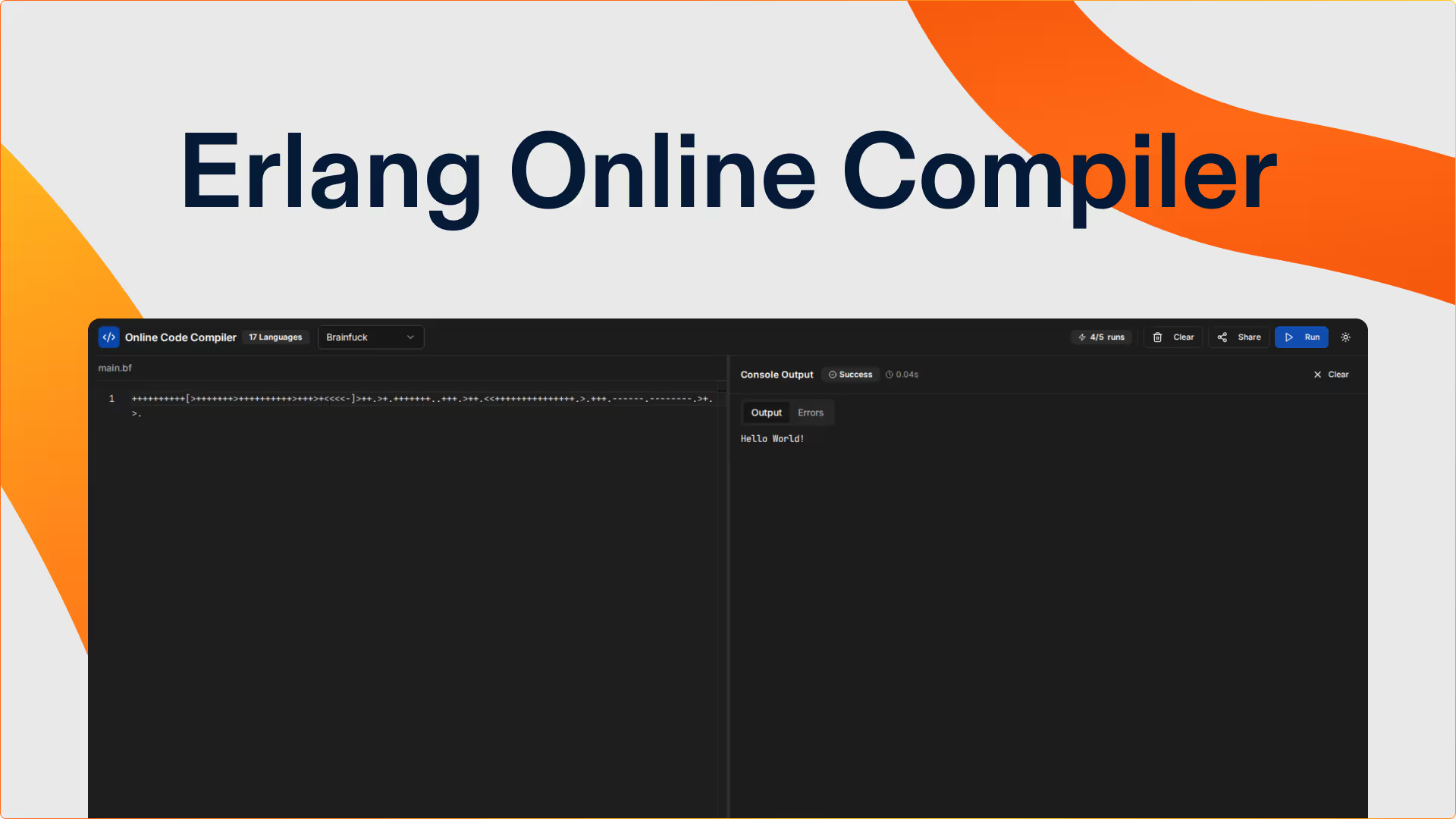


































Online Erlang Compiler Features
Battle-Tested Concurrency Platform
- Erlang/OTP 26 Environment - Latest runtime powering WhatsApp's 2 billion users and telecom switches worldwide
- Actor Model Excellence - Spawn thousands of lightweight processes, each with isolated memory—no shared state nightmares
- Message Passing Mastery - Test send/receive patterns with mailbox processing that scales to millions of concurrent connections
- Pattern Matching Power - Write cleaner code with Erlang's declarative pattern matching in function heads and case expressions
- Let It Crash Philosophy - Experience fault tolerance where processes fail gracefully and supervisors restart them automatically
Telecom-Grade Reliability Testing
- Supervisor Trees - Build self-healing applications with OTP supervisor behaviors that restart failed components
- GenServer Implementation - Practice stateful server design using battle-proven OTP generic server patterns
- Hot Code Swapping - Learn how Erlang updates running systems without downtime—critical for 99.999% uptime
- Error Kernel Design - Test isolation boundaries where crashes in one feature don't bring down your entire system
Distributed Systems Playground
- Node Communication - Understand distributed Erlang concepts for building cluster-aware applications
- ETS Tables - Work with Erlang Term Storage for microsecond-latency in-memory data access
- Process Registry - Practice naming and discovering processes across distributed nodes
- Mnesia Database Basics - Test distributed database patterns in single-node environment
Zero-Setup Learning Environment
- No BEAM VM Installation - Skip complex Erlang/OTP setup and dive straight into concurrent programming
- Instant Process Visualization - See process spawning, message passing, and supervision in action
- Share Working Examples - Generate URLs to demonstrate concurrent algorithms to colleagues or students
- Interview Preparation - Practice Erlang coding challenges for companies using BEAM ecosystem
Erlang Keyboard Shortcuts
Experience the power of Replit AI

This entire Erlang compiler was built by Replit Agent 3 from a natural language prompt. Replit's environment facilitates rapid development, iteration and testing code for users of any technical ability. Develop software faster and better with Replit’s autonomous AI.
Get started freeFrequently Asked Questions
What makes Erlang different from other concurrent languages?
Erlang uses lightweight processes (not OS threads) that are completely isolated—no shared memory means no locks or race conditions. Each process has its own heap and communicates only through message passing. This erlang online compiler lets you experience this unique model instantly.
Can I test OTP behaviors like GenServer and Supervisor?
Yes! You can implement gen_server callbacks, create supervisor specifications, and test gen_statem state machines. While full distributed features work best locally, this erlang code runner demonstrates OTP patterns perfectly for learning and prototyping concurrent architectures.
How do I debug concurrent Erlang processes online?
Use io:format/2 to trace message flow between processes. The output shows process spawning, message sends, and receives in order. For complex debugging, consider signing up for Replit where you can fork this erlang compiler and customize it with AI assistance for advanced tracing.
Is Erlang still relevant in modern development?
Absolutely! WhatsApp serves 2 billion users with just 50 engineers using Erlang. Discord, RabbitMQ, CouchDB, and many IoT platforms rely on Erlang's fault tolerance. This online erlang compiler helps you learn the language powering critical infrastructure worldwide.
What's the difference between Erlang and Elixir?
Both run on the BEAM VM and share OTP, but Elixir offers Ruby-like syntax and metaprogramming. This erlang editor focuses on pure Erlang—the foundation that makes both languages excel at building resilient, concurrent systems. Master Erlang first to understand the platform's power.
Can I simulate distributed Erlang nodes?
This single-node environment demonstrates concurrent programming concepts, message passing, and OTP behaviors. For multi-node testing with distributed Erlang, sign up for Replit to fork this erlang online editor and extend it with AI help for cluster simulation.
How does Erlang achieve nine 9s (99.9999999%) uptime?
Through supervisor hierarchies that restart failed processes, hot code reloading without stopping the system, and process isolation preventing cascading failures. Test these concepts in our erlang code runner to understand how Ericsson achieved 31ms downtime per year.
What are typical Erlang use cases?
Messaging systems (WhatsApp, Discord), IoT platforms, telecom switches, distributed databases (Riak, CouchDB), message queues (RabbitMQ), and real-time bidding systems. This online erlang compiler helps you prototype these architectures before committing to production deployment.
Build, test, and ship faster than ever with Replit
Replit is the only platform that combines a cloud IDE, Agentic Al coding, and seamless team collaboration to help you prototype and ship apps in record time. Build in 50+ languages, work from any device, and deploy in one click — no setup required.

